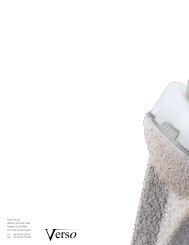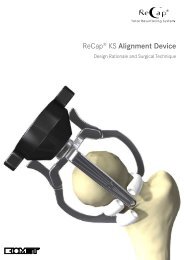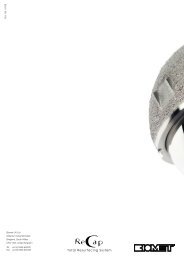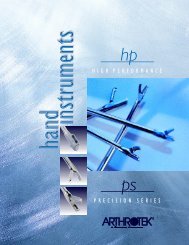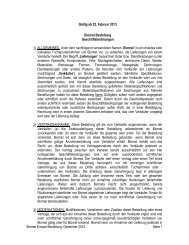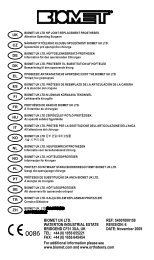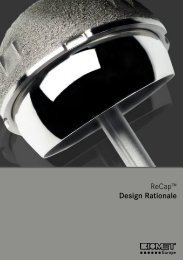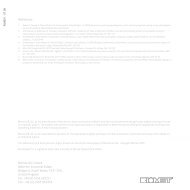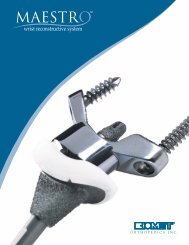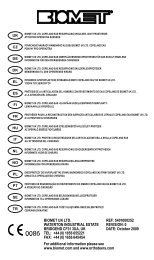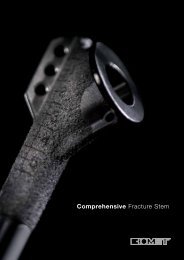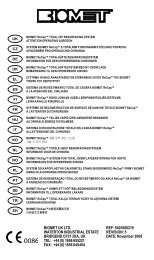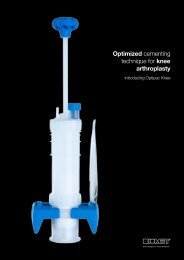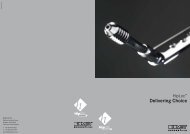Taperloc Complete Hip System - Biomet
Taperloc Complete Hip System - Biomet
Taperloc Complete Hip System - Biomet
You also want an ePaper? Increase the reach of your titles
YUMPU automatically turns print PDFs into web optimized ePapers that Google loves.
<strong>Taperloc</strong> <strong>Complete</strong> <strong>Hip</strong> <strong>System</strong>
One Surgeon. One Patient.<br />
Over 1 million times per year, <strong>Biomet</strong> helps one surgeon<br />
provide personalized care to one patient.<br />
The science and art of medical care is to provide the right<br />
solution for each individual patient. This requires clinical<br />
mastery, a human connection between the surgeon and the<br />
patient, and the right tools for each situation.<br />
At <strong>Biomet</strong>, we strive to view our work through the eyes of<br />
one surgeon and one patient. We treat every solution we<br />
provide as if it’s meant for a family member.<br />
Our approach to innovation creates real solutions that assist<br />
each surgeon in the delivery of durable personalized care<br />
to each patient, whether that solution requires a minimally<br />
invasive surgical technique, advanced biomaterials or a<br />
patient-matched implant.<br />
When one surgeon connects with one patient to provide<br />
personalized care, the promise of medicine is fulfilled.
<strong>Taperloc</strong> <strong>Complete</strong> <strong>Hip</strong> <strong>System</strong><br />
Over the past 26 years, the <strong>Taperloc</strong> <strong>Hip</strong> stem has<br />
become the industry standard in cementless hip<br />
arthroplasty. 1 Combining this unmatched clinical<br />
success with <strong>Biomet</strong>’s commitment to product<br />
innovation, the <strong>Taperloc</strong> <strong>Complete</strong> <strong>Hip</strong> system has<br />
been introduced with design enhancements that<br />
restore leg length, stability, offset and range of motion<br />
(ROM) accurately and consistently.<br />
Clinical Success of the <strong>Taperloc</strong> <strong>Hip</strong> <strong>System</strong><br />
100% Survivorship<br />
at a minimum 5 year follow-up in 49 rheumatoid patients 2<br />
100% Survivorship<br />
at a 2–11 year follow-up in 114 patients 80 years old<br />
or older 3<br />
99.6% Survivorship<br />
at a 12 year follow-up of 4,750 patients 4<br />
99% Survivorship<br />
at a 22–26 year follow-up in 138 patients 1<br />
99% Survivorship<br />
at a 12 year follow-up in 115 patients 5<br />
98% Survivorship<br />
at 8–13 year follow-up in 91 patients 50 years old<br />
or younger 6<br />
95% Survivorship<br />
at a 10–18 year follow-up in 89 obese patients 7<br />
94% Survivorship<br />
at a 10–18 year follow-up in 99 non-obese patients 7<br />
1
<strong>Taperloc</strong> <strong>Complete</strong> Full Profile <strong>Hip</strong> Stem<br />
Polished Anterior-Posterior<br />
Neck Flats<br />
Increase ROM by geometrically<br />
reducing the potential for<br />
impingement of the neck<br />
with the cup 8<br />
Rotational Stability<br />
Insertion Hole<br />
Provides rotational stability<br />
upon implantation<br />
Clinically Proven<br />
PPS Application<br />
Allows for initial<br />
scratch-fit stability<br />
and bone fixation 2,3,9,10<br />
Optimal Neck Angle<br />
133° neck angle increases<br />
ROM and improves stability<br />
through increased soft<br />
tissue tension 14–16<br />
Offset Option<br />
Standard and high offset<br />
options reproduce various<br />
patient anatomies without<br />
lengthening the leg<br />
Acetabular Options<br />
2<br />
Exceed ABT with Biolox ® delta<br />
Exceed ABT with E1<br />
Ceramic Tapered Liner and 15°<br />
shell<br />
• Improved wear resistance and<br />
mechanical strength compared<br />
to alumina ceramic.<br />
• Increased diameters improve<br />
ROM<br />
• 15° shell option allows more<br />
coverage<br />
• Clinically proven PPS coating 9,17<br />
• Utilises clinically proven RingLoc<br />
mechanism<br />
• E1 Antioxidant Infused Technology<br />
developed from clinically proven<br />
ArCom 18,19<br />
• Ultra low wear versus standard<br />
polyethylene 20<br />
• Range of liner types and sizes to<br />
better address clinical need:<br />
– Standard, Hi-Wall and 10 Degree<br />
– 22, 28, 32, 36 and 40 mm liners
BoneMaster Nano-Crystalline<br />
HA Coating Technology<br />
BoneMaster Coating<br />
Provides enhanced<br />
implant stability, 11 reduced<br />
fibrous in-growth 11,12 and<br />
increased bone density 12,13<br />
BoneMaster is an advanced biomimetic<br />
coating technology with the biological<br />
benefits of hydroxyapatite and an enhanced<br />
needle-like nano-structure based on apatite<br />
crystals found in bone. 26 This technology offers<br />
enhanced implant stability, 11 reduced fibrous<br />
in-growth 11,12 and increased bone density. 12,13<br />
Flat Tapered Wedge<br />
Geometry<br />
Enhances proximal offloading<br />
and bone preservation and<br />
provides for rotational stability<br />
2µm<br />
BoneMaster coating<br />
Bone<br />
Titanium Alloy Ti-6AL-4V<br />
Flexibility of titanium allows for<br />
stress transfer to preserve<br />
cortical density<br />
The unique needle-like topography of<br />
BoneMaster creates a favorable environment<br />
for osteoblast adhesion, producing faster<br />
bone integration. The 5μm thick BoneMaster<br />
coating preserves the macro-roughness<br />
and porosity of PPS (Porous Plasma Spray)<br />
Ti-alloy coating for enhanced primary and<br />
long-term fixation. 27–29<br />
Dual Mobility Technology<br />
• Large head for reduced risk of<br />
dislocation 21<br />
• Large ROM 22<br />
• 90% – lower wear – than traditional<br />
ArCom 23<br />
• Clinically proven cup design 24,25<br />
• Available in Active Articulation and<br />
Avantage Dual Mobility <strong>System</strong><br />
constructs<br />
Uncoated Surface<br />
Fibrous tissue<br />
Bone tissue<br />
BoneMaster Coating<br />
Titanium<br />
3
<strong>Taperloc</strong> <strong>Complete</strong> Reduced Distal <strong>Hip</strong> Stem<br />
Polished Anterior-Posterior<br />
Neck Flats<br />
Increase ROM by geometrically<br />
reducing the potential for<br />
impingement of the neck<br />
with the cup 8<br />
Rotational Stability<br />
Insertion Hole<br />
Provides rotational stability<br />
upon implantation<br />
Clinically Proven<br />
PPS Application<br />
Allows for initial<br />
scratch-fit stability<br />
and bone fixation 2,3,9,10<br />
Optimal Neck Angle<br />
133° neck angle increases<br />
ROM and improves stability<br />
through increased soft<br />
tissue tension 14–16<br />
E1 Technology<br />
Offset Option<br />
Standard and high offset<br />
options reproduce various<br />
patient anatomies without<br />
lengthening the leg<br />
Reduced Distal<br />
Transition<br />
Enhances implant fit<br />
in femoral canals with a<br />
proximal/distal mismatch<br />
Infused with vitamin E, a natural antioxidant, E1 Technology<br />
defines a new class of acetabular bearings. It overcomes<br />
the limitations of remelted and annealed polyethylenes,<br />
as well as blended antioxidant polyethylenes, by<br />
maximizing ultra-low wear, high mechanical strength and<br />
true oxidative stability. 30,31<br />
Oxidation Index (Absorbance Units)<br />
0.8<br />
0.7<br />
0.6<br />
0.5<br />
0.4<br />
0.3<br />
0.2<br />
0.1<br />
0.0<br />
Oxidation Profile 30,32<br />
After ESC testing<br />
-0.1<br />
Top<br />
Surface<br />
Center<br />
Bottom<br />
Surface<br />
Sequentially Crosslinked and Annealed Loaded<br />
Sequentially Crosslinked and Annealed Control<br />
E1 Material Loaded<br />
4<br />
E1 Material Control
<strong>Taperloc</strong> <strong>Complete</strong><br />
Reduced Distal Geometry<br />
BoneMaster Coating<br />
Provides enhanced<br />
implant stability, 11 reduced<br />
fibrous in-growth 11,12 and<br />
increased bone density 12,13<br />
Flat Tapered Wedge<br />
Geometry<br />
Enhances proximal offloading<br />
and bone preservation and<br />
provides for rotational stability<br />
The <strong>Taperloc</strong> <strong>Complete</strong> stem features a<br />
reduced distal geometry in which a gradual<br />
reduction of the stem substrate occurs distal<br />
to the porous coating level. The <strong>Taperloc</strong><br />
<strong>Complete</strong> stem’s reduced distal geometry<br />
enhances the proximal fill of the implant in<br />
the metaphysis. This particular design is the<br />
optimal choice to address a proximal/distal<br />
mismatch, which is common in a Dorr Type A<br />
femur, by properly accommodating the<br />
proximal metaphysis without the need to fit a<br />
narrow distal femoral geometry. This design<br />
enhancement is based on the traditional<br />
<strong>Taperloc</strong> Reduced Distal stem which has<br />
been clinically successfully for over 16 years. 5<br />
Titanium Alloy Ti-6AL-4V<br />
Flexibility of titanium allows for<br />
stress transfer to preserve<br />
cortical density<br />
30<br />
27.44<br />
Volumetric Wear Rates<br />
of 38mm Acetabular Liners 30<br />
5 Million Cycles<br />
38mm Head Size<br />
25<br />
Volumetric Wear Rate<br />
(mm 3 /MC)<br />
20<br />
15<br />
10<br />
5<br />
15.62<br />
89% large<br />
head wear<br />
reduction over<br />
ArComXL<br />
Polyethylene<br />
3.16<br />
1.71 1.37<br />
The <strong>Taperloc</strong> <strong>Complete</strong> stem design accurately<br />
addresses a proximal/distal mismatch as seen<br />
in the x-ray above.<br />
0<br />
CoCr/ BIOLOX ®<br />
ArComXL delta/<br />
Polyethylene ArComXL<br />
Polyethylene<br />
CoCr/<br />
E1<br />
Material<br />
BIOLOX ®<br />
delta/<br />
E1<br />
Material<br />
Metal-on-<br />
Metal<br />
(Run-in Wear)<br />
5
<strong>Taperloc</strong> <strong>Complete</strong> Microplasty <strong>Hip</strong> Stem<br />
Polished Anterior-Posterior<br />
Neck Flats<br />
Increase ROM by geometrically<br />
reducing the potential for<br />
impingement of the neck<br />
with the cup 8<br />
Rotational Stability<br />
Insertion Hole<br />
Provides rotational stability<br />
upon implantation<br />
Clinically Proven<br />
PPS Application<br />
Allows for initial<br />
scratch-fit stability<br />
and bone fixation 2,3,9,10<br />
Optimal Neck Angle<br />
133° neck angle increases<br />
ROM and improves stability<br />
through increased soft<br />
tissue tension 14–16<br />
Offset Option<br />
Standard and high offset<br />
options reproduce various<br />
patient anatomies without<br />
lengthening the leg<br />
Reduced Distal<br />
Transition<br />
Enhances implant fit<br />
in femoral canals with<br />
proximal/distal mismatch<br />
Surgeon Education Opportunities<br />
The Anterior Supine Intramuscular (ASI) approach has<br />
shown many patient benefits 33–35 whether utilizing a<br />
specialized fracture or standard operating table. <strong>Biomet</strong><br />
offers a number of resources for surgeons to explore the<br />
ASI approach in the manner that best suits surgeon and<br />
hospital needs.<br />
6
BoneMaster Coating<br />
Provides enhanced<br />
implant stability, 11 reduced<br />
fibrous in-growth 11,12 and<br />
increased bone density 12,13<br />
<strong>Taperloc</strong> <strong>Complete</strong><br />
Microplasty Stem<br />
The <strong>Taperloc</strong> <strong>Complete</strong> Microplasty stem is<br />
built upon the strong clinical heritage of the<br />
<strong>Taperloc</strong> stem and incorporates the same<br />
design enhancements as the <strong>Taperloc</strong><br />
<strong>Complete</strong> full length stem. This stem option<br />
has been shortened 35 mm from the standard<br />
Titanium Alloy Ti-6AL-4V<br />
Flexibility of titanium allows for<br />
stress transfer to preserve<br />
cortical density<br />
length stem to better address minimally invasive<br />
techniques, provide an alternative to femoral<br />
resurfacing and offer a unique solution in<br />
cases where a bone conserving prosthesis is<br />
desirable.<br />
Flat Tapered Wedge<br />
Geometry<br />
Enhances proximal offloading<br />
and bone preservation and<br />
provides for rotational stability<br />
Reduced Length<br />
Stem length reduced 35 mm<br />
to preserve soft tissues and<br />
bony structures and better<br />
accommodate minimally<br />
invasive approaches<br />
ASI <strong>Hip</strong> Instructional Courses<br />
• Courses offered with standard OR and ASI specific tables<br />
• Led by experienced ASI faculty<br />
• Didactic and hands-on cadaveric training<br />
Surgeon Visitation Program<br />
• One-on-one experience with ASI surgeon<br />
• Observe live surgery<br />
• Discuss implant design and rationale<br />
For more information on these opportunities, please visit<br />
biometosa.com.<br />
7
<strong>Taperloc</strong> <strong>Complete</strong> XR 123° <strong>Hip</strong> Stem<br />
Polished Anterior-Posterior<br />
Neck Flats<br />
Increase ROM by geometrically<br />
reducing the potential for<br />
impingement of the neck<br />
with the cup 8<br />
Rotational Stability<br />
Insertion Hole<br />
Provides rotational stability<br />
upon implantation<br />
Clinically Proven<br />
PPS Application<br />
Allows for initial<br />
scratch-fit stability<br />
and bone fixation 2,3,9,10<br />
123° Neck Angle<br />
Addresses varus anatomies<br />
or coxa vara femoral types by<br />
providing additional horizontal<br />
offset and low vertical offset for<br />
increased soft tissue tension<br />
Reduced Distal<br />
Transition<br />
Enhances implant fit<br />
in femoral canals with<br />
proximal/distal mismatch<br />
<strong>Taperloc</strong> <strong>Complete</strong> <strong>Hip</strong> <strong>System</strong><br />
Maximum Offset Range<br />
With the introduction of the<br />
<strong>Taperloc</strong> <strong>Complete</strong> XR 123° stem<br />
option, the <strong>Taperloc</strong> <strong>Complete</strong><br />
system can accommodate a<br />
larger range of offsets to better<br />
restore patient biomechanics.<br />
The adjacent chart shows the<br />
additional offsets achieved with<br />
the <strong>Taperloc</strong> <strong>Complete</strong> compared<br />
to a competitive system.<br />
Vertical Offset (mm)<br />
50<br />
45<br />
40<br />
35<br />
30<br />
25<br />
Competitive Stem Offset Range<br />
<strong>Taperloc</strong> <strong>Complete</strong> Standard Offset Range<br />
<strong>Taperloc</strong> <strong>Complete</strong> High Offset Range<br />
<strong>Taperloc</strong> <strong>Complete</strong> XR 123° Offset Range<br />
20<br />
20.00 25.00 30.00 35.00 40.00 45.00 50.00 55.00 60.00 65.00<br />
Horizontal Offset (mm)<br />
8
BoneMaster Coating<br />
Provides enhanced<br />
implant stability, 11 reduced<br />
fibrous in-growth 11,12 and<br />
increased bone density 12,13<br />
Titanium Alloy Ti-6AL-4V<br />
Flexibility of titanium allows for<br />
stress transfer to preserve<br />
cortical density<br />
<strong>Taperloc</strong> <strong>Complete</strong> XR<br />
123° Stem<br />
The <strong>Taperloc</strong> <strong>Complete</strong> XR 123° stem option<br />
has the same stem geometry as the <strong>Taperloc</strong><br />
<strong>Complete</strong> Full length and Microplasty stems,<br />
but provides a 123° degree neck angle and a<br />
shortened neck length by 2 mm. These unique<br />
design features help to address femurs with<br />
a more varus neck by allowing for additional<br />
offset to properly restore hip biomechanics and<br />
soft tissue tensioning.<br />
133° Standard<br />
Offset<br />
133° High Offset<br />
Flat Tapered Wedge<br />
Geometry<br />
Enhances proximal offloading<br />
and bone preservation and<br />
provides for rotational stability<br />
123° Neck Angle<br />
133° Standard<br />
Offset<br />
133° High<br />
Offset<br />
Profile Options<br />
Available in Full Length<br />
Reduced Distal and<br />
Microplasty stem options<br />
123° Neck<br />
Angle
References<br />
1. McLaughlin, J.R. and Lee, K.R. Survivorship at 22 to 26 Years Reported<br />
with Uncemented Tapered Total <strong>Hip</strong> Stem. Orthopedics Today. 30(1): 1,<br />
2010.<br />
2. Rothman, R. et al. Cementless Femoral Fixation in the Rheumatoid Patient<br />
Undergoing Total <strong>Hip</strong> Arthroplasty: Minimum 5 Year Results. Journal of<br />
Arthroplasty. 16(4): 415–21, 2001.<br />
3. Keisu, K.S. et al. Primary Cementless Total <strong>Hip</strong> Arthroplasty in<br />
Octogenarians: Two to Eleven Year Follow-up. Journal of Bone and Joint<br />
Surgery. 83: 359, 2001.<br />
4. Hozack, W. Ten Year Experience with a Wedge Fit Stem. Crucial Decisions<br />
in Total Joint Replacement and Sports Medicine. Presentation. Bermuda,<br />
1999.<br />
5. McLaughlin, J.R. and Lee, K.R. Cementless Total hip Replacement Using<br />
Second-generation Components. Journal of Bone and Joint Surgery<br />
(British). 92(12): 1636–41, 2010.<br />
6. McLaughlin, J.R. and Lee, K.R. The Outcome of Total <strong>Hip</strong> Arthroplasty in<br />
Young Patients. 8- to 13-Year Results Using an Uncemented Stem. Clinical<br />
Orthopaedics and Related Research. 373: 153–63, 2000.<br />
7. McLaughlin, J.R. and Lee, K.R. The Outcome of Total <strong>Hip</strong> Replacement in<br />
Obese and Non-obese Patients at 10- to 18-Years. Journal of Bone and<br />
Joint Surgery (British). 1286–92, 2006.<br />
8. Davey J.R., Femoral Offset. http://orthonet.on.ca/emerging trends/notes/<br />
Femoral%20Offset.htm (accessed February 15, 2010).<br />
9. McLaughlin, J. et al. Total <strong>Hip</strong> Arthroplasty with an Uncemented Tapered<br />
Femoral Component. Journal of Bone and Joint Surgery. 6(90):1290–6,<br />
2008.<br />
10. Rothman, R. et al. Immediate Weight Bearing after Uncemented Total <strong>Hip</strong><br />
Arthroplasty. Clinical Orthopedics and Related Research. 349: 156–62,<br />
1998.<br />
11. Schmidmaier G, Wildemann B, Schwabe P, Stange R, Hoffmann J,<br />
Südkamp NP, Haas NP, Raschke M (2002) A new electrochemically graded<br />
hydroxyapatite coating for osteosynthetic implants promotes implant osteointegration<br />
in a rat model. J Biomed Mater Res 63: 168–172,<br />
12. Schliephake H, Scharnweber D, Roesseler S, Dard M, Sewing A, Aref A<br />
(2006) Biomimetic calcium phosphate composite coating of dental implants,<br />
Int J Oral Maxillofac Implants , 21 (5):738-46<br />
13. Schliephake H, Scharnweber D, Dard M, Rößler S, Sewing A and<br />
Hüttmann C (2003) Biological performance of biomimetic calcium phosphate<br />
coating of titanium implants in the mandible a pilot study in dogs, J<br />
Biomed Mat Res 64A: 225-234<br />
14. Bourne R.B. and Rorabeck C.H. Soft Tissue Balancing: The <strong>Hip</strong>. Journal<br />
of Arthroplasty. 17(4):17–22, 2002<br />
15. Charnley J. Low Friction Principle. Charnley J. Low Friction Arthroplasty of<br />
the <strong>Hip</strong>. New York: Springer-Verlag. 3–15, 1979.<br />
16. McGrory B.J. et al. Effect of Femoral Offset on Range of Motion and<br />
Abductor Muscle Strength after Total <strong>Hip</strong> Arthroplasty. Journal of Bone and<br />
Joint Surgery (British). 17(4): 865–9, 1995.<br />
19. Nabar, S. et al. Comparison of Second Generation Highly Crosslinked<br />
Polyethylenes Under Adverse Aging Conditions. Poster No. 1684. 54th<br />
Annual Meeting of the Orthopaedic Research Society. 2008.<br />
20. <strong>Biomet</strong> Biomaterials Laboratory. The Revolutionary Second Generation<br />
Vitamin E Stabilized Highly Crosslinked UHMWPE. Jan 2007.<br />
21. Beaule, P.E. et al. Jumbo Femoral Head for the Treatment of Recurrent<br />
Dislocation Following Total <strong>Hip</strong> Replacement. Journal of Bone and Joint<br />
Surgery. 84A(2): 256–63, 2002.<br />
22. Data on file at <strong>Biomet</strong>. Information of files 10.04.12 Avantage ROM not<br />
necessarily indicative of clinical performance.<br />
23. Data on File at <strong>Biomet</strong>. Bench test results not necessarily indicative of clinical<br />
performance.<br />
24. Leclercq, S. et al. Charnley-Kerboull-Bonsquet Hybrid THR After 10 Years.<br />
Total <strong>Hip</strong> Arthroplasty. Conference. 3rd International Symposium. 2000.<br />
25. Tarasevicius, S., Busevicius, M., Robertsson, O., Wingstrand, H.<br />
et al. Dual Mobility Cup Reduces Dislocation Rate After Arthroplasty for<br />
Femoral Neck Fracture. BMC Musculoskeletal Disorders Journal. 11:175,<br />
2010<br />
26. Robler S, Sewing A, Stolzel M, Born R, Scharnweber S, Dard M, Warch<br />
H (2003) Electrochemically assisted deposition of thin calcium phosphate<br />
coating at near-physiological pH and temperature. J<strong>Biomet</strong> Mater Res<br />
64A:655-663<br />
27. Mont MA, Hungarford DS (1997) Proximally Coated Ingrowth Prosthesis. A<br />
Review. Clin Orthop 344: 139-149<br />
28. Emerson RH , Sanders SB, Head WC, Higgins L (1999) Effect of circumferential<br />
plasma-spray porous coating on the rate of femoral osteolysis after<br />
total hip arthroplasty. JBJS 81: 1291-1298<br />
29. Bourne RB, Rorabeck CH, Burkart BC, Kirk P (1994) Ingrowth surfaces:<br />
Plasma spray coating to titanium alloy hip replacements. Clin Orthop Relat<br />
Res 298: 37-46<br />
30. Data on file at <strong>Biomet</strong>. Bench test results not necessarily indicative of clinical<br />
performance.<br />
31. Kurtz, S. et al. The UHMWPE Handbook: Ultra High Molecular Weight<br />
Polyethylene in Total Joint Replacement. Elsevier Academic Press. San<br />
Diego, CA. 2004.<br />
32. Nabar, S. et al. Comparison of Second Generation Highly Crosslinked<br />
Polyethylenes Under Adverse Aging Conditions. ORS 2008. Poster No.<br />
1684.<br />
33. Kennon R. et al. Anterior Approach for Total <strong>Hip</strong> Arthroplasty: Beyond the<br />
Minimally Invasive Technique. Journal of Bone and Joint Surgery. 86(2):<br />
91–7, 2004.<br />
34. Nakata, K. et al. A Clinical Comparative Study of the Direct Anterior With<br />
Mini-Posterior Approach. Journal of Arthroplasty. 24(5): 698–704, 2009.<br />
35. Bal, B.S. et al. Early Complications of Primary Total <strong>Hip</strong> Replacement<br />
Performed with a Two-Incision Minimally Invasive Technique. Journal of<br />
Bone and Joint Surgery. 87(11): 2432–8, 2005.<br />
17. Multi-Center Study. Data on file at <strong>Biomet</strong>.<br />
18. Meding, J. 4.4mm of Tibial Polyethylene: A Ten-Year Follow-Up Study.<br />
Clinical Orthopedics and Related Research. 388: 112–7.<br />
BIOLOX ® delta is a trademark of CeramTec AG.<br />
All trademarks herein are the property of <strong>Biomet</strong>, Inc. or its subsidiaries unless<br />
otherwise indicated.<br />
This publication and all content, artwork, photographs, names, logos and marks<br />
contained in it are protected by copyright, trademarks and other intellectual property<br />
rights owned by or licensed to <strong>Biomet</strong> or its affiliates. This publication must<br />
not be used, copied or reproduced in whole or in part for any purposes other than<br />
marketing by <strong>Biomet</strong> or its authorized representatives. Use for any other purposes<br />
is prohibited.<br />
©2012 <strong>Biomet</strong> Orthopedics • Form No. FLH235 • REV061512<br />
Responsible Manufacturer<br />
<strong>Biomet</strong>, inc.<br />
P.O. Box 587<br />
56 E. Bell Drive<br />
Warsaw, Indiana 46581-0587<br />
USA<br />
www.biomet.com<br />
European Representative<br />
<strong>Biomet</strong> UK, Ltd.<br />
Waterton Industrial Estate<br />
Bridgend, South Wales<br />
CF31 3XA<br />
UK<br />
www.biometeurope.com



